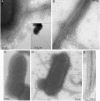Demonstration of Type IV pilus expression and a twitching phenotype by Haemophilus influenzae
- PMID: 15731063
- PMCID: PMC1064948
- DOI: 10.1128/IAI.73.3.1635-1643.2005
Demonstration of Type IV pilus expression and a twitching phenotype by Haemophilus influenzae
Abstract
Haemophilus influenzae is considered a nonmotile organism that expresses neither flagella nor type IV pili, although H. influenzae strain Rd possesses a cryptic pilus locus. We demonstrate here that the homologous gene cluster pilABCD in an otitis media isolate of nontypeable H. influenzae strain 86-028NP encodes a surface appendage that is highly similar, structurally and functionally, to the well-characterized subgroup of bacterial pili known as type IV pili. This gene cluster includes a gene (pilA) that likely encodes the major subunit of the heretofore uncharacterized H. influenzae-expressed type IV pilus, a gene with homology to a type IV prepilin peptidase (pilD) as well as two additional uncharacterized genes (pilB and pilC). A second gene cluster (comABCDEF) was also identified by homology to other pil or type II secretion system genes. When grown in chemically defined medium at an alkaline pH, strain 86-028NP produces approximately 7-nm-diameter structures that are near polar in location. Importantly, these organisms exhibit twitching motility. A mutation in the pilA gene abolishes both expression of the pilus structure and the twitching phenotype, whereas a mutant lacking ComE, a Pseudomonas PilQ homologue, produced large appendages that appeared to be membrane bound and terminated in a slightly bulbous tip. These latter structures often showed a regular pattern of areas of constriction and expansion. The recognition that H. influenzae possesses a mechanism for twitching motility will likely profoundly influence our understanding of H. influenzae-induced diseases of the respiratory tract and their sequelae.
Figures






Similar articles
-
Analysis of pilus adhesins from Haemophilus influenzae biotype IV strains.Infect Immun. 2001 Nov;69(11):7010-9. doi: 10.1128/IAI.69.11.7010-7019.2001. Infect Immun. 2001. PMID: 11598076 Free PMC article.
-
Evidence for donor strand complementation in the biogenesis of Haemophilus influenzae haemagglutinating pili.Mol Microbiol. 2000 Mar;35(6):1335-47. doi: 10.1046/j.1365-2958.2000.01816.x. Mol Microbiol. 2000. PMID: 10760135
-
Cloning of an Aeromonas hydrophila type IV pilus biogenesis gene cluster: complementation of pilus assembly functions and characterization of a type IV leader peptidase/N-methyltransferase required for extracellular protein secretion.Mol Microbiol. 1996 Feb;19(4):857-69. doi: 10.1046/j.1365-2958.1996.431958.x. Mol Microbiol. 1996. PMID: 8820654
-
Molecular genetic analysis of type-4 pilus biogenesis and twitching motility using Pseudomonas aeruginosa as a model system--a review.Gene. 1997 Jun 11;192(1):109-15. doi: 10.1016/s0378-1119(97)00037-1. Gene. 1997. PMID: 9224880 Review.
-
Archaeal flagella, bacterial flagella and type IV pili: a comparison of genes and posttranslational modifications.J Mol Microbiol Biotechnol. 2006;11(3-5):167-91. doi: 10.1159/000094053. J Mol Microbiol Biotechnol. 2006. PMID: 16983194 Review.
Cited by
-
Nontypeable Haemophilus influenzae Responds to Virus-Infected Cells with a Significant Increase in Type IV Pilus Expression.mSphere. 2020 May 27;5(3):e00384-20. doi: 10.1128/mSphere.00384-20. mSphere. 2020. PMID: 32461275 Free PMC article.
-
Membrane morphology and leukotoxin secretion are associated with a novel membrane protein of Aggregatibacter actinomycetemcomitans.J Bacteriol. 2008 Sep;190(17):5972-80. doi: 10.1128/JB.00548-08. Epub 2008 Jul 11. J Bacteriol. 2008. PMID: 18621903 Free PMC article.
-
A Robust Protocol to Isolate Outer Membrane Vesicles from Nontypeable Haemophilus influenzae.Methods Protoc. 2023 Apr 7;6(2):42. doi: 10.3390/mps6020042. Methods Protoc. 2023. PMID: 37104024 Free PMC article.
-
Novel type IV secretion system involved in propagation of genomic islands.J Bacteriol. 2007 Feb;189(3):761-71. doi: 10.1128/JB.01327-06. Epub 2006 Nov 22. J Bacteriol. 2007. PMID: 17122343 Free PMC article.
-
Bacterial biofilms in the upper airway - evidence for role in pathology and implications for treatment of otitis media.Paediatr Respir Rev. 2012 Sep;13(3):154-9. doi: 10.1016/j.prrv.2012.03.001. Epub 2012 May 27. Paediatr Respir Rev. 2012. PMID: 22726871 Free PMC article. Review.
References
-
- Aas, F. E., M. Wolfgang, S. Frye, S. Dunham, C. Lovold, and M. Koomey. 2002. Competence for natural transformation in Neisseria gonorrhoeae: components of DNA binding and uptake linked to type IV pilus expression. Mol. Microbiol. 46:749-760. - PubMed
-
- Alm, R. A., and J. S. Mattick. 1997. Genes involved in the biogenesis and function of type-4 fimbriae in Pseudomonas aeruginosa. Gene 192:89-98. - PubMed
-
- Barcak, G. J., M. S. Chandler, R. J. Redfield, and J. F. Tomb. 1991.Genetic systems in Haemophilus influenzae. Methods Enzymol. 204:321-342. - PubMed
Publication types
MeSH terms
Substances
Associated data
- Actions
- Actions
- Actions
- Actions
- Actions
- Actions
- Actions
- Actions
- Actions
- Actions
- Actions
- Actions
Grants and funding
LinkOut - more resources
Full Text Sources
Other Literature Sources
Miscellaneous

